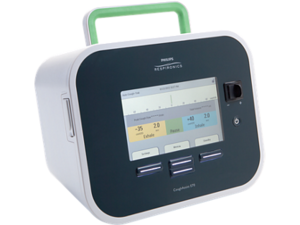Assisted Coughing
Description

It is most useful in patients with an ineffective cough due to muscle weakness, in conditions such as muscular dystrophies, myasthenia gravis, SMA, Spinal cord lesions, MND etc.
In conditions such as spinal cord injury or neuromuscular disease an individual may require assistance to cough using manual techniques or a medical device.Manual assisted cough is the compression of the diaphragm by another person to replace the work of abdominal muscles in order to facilitate a cough. A medical device can be used to assist coughing effort by a positive pressure breath followed by a rapid change to negative pressure.
Indication
- A patient unable to clear secretions effectively due to muscle weakness
- Peak cough flows of >180 L/min are unlikely to be effective at clearing secretions
- Can be useful in preventing respiratory complications due to secretion retention and poor tidal volumes
Clinical presentation
- Subjectively ‘chesty’
- Audible secretions at the mouth
- Crackles heard on auscultation
- Tactile fremitus
- Hypoxemia
- Non productive cough
- Poor inspiratory efforts
Contraindications
| Manual assisted cough | Cough assist device |
|---|---|
| Direct pressure should be avoided to rib fractures or surgical sites. | Undrained pneumothorax Frank haemoptysis Vomiting Facial fractures CVS instability Raised intracranial pressure (ICP) Recent upper GI surgery Lung abscess |
Precautions
| Manual assisted cough | Cough assist device |
|---|---|
| Immediately following surgery Paralytic ileus Rib fractures Raised ICP Undrained pneumothorax Osteroporosis Pain Unstable spine | Oxygen dependency Bronchospasm Emphysema Patient complience Airway obstruction |
Cautions
- Cardiovascular instability
- Coagulopathy
- High Oxygen requirements
- Asthma or air trapping
- Full tummy!
Side effects
- Abdominal distension
- Chest soreness
- Fatigue
- Oxygen desaturation
Setting up the Cough assist
- Plug in the cough assist and ensure it is on a flat, stable surface
- Set up the circuit – machine, filter, tubing, mask
- Position patient as needed
First, set the expiratory pressure
- Turn on the machine and set to MANUAL
- Occlude the tubing with your gloved hand and push the manual control to EXHALATION
- Observe pressure gauge and adjust to desired level using the main PRESSURE CONTROL
Next, set the inspiratory pressure
- Inspiratory pressure matches the Expiratory pressure when the INHALE PRESSURE dial is turned to the far right.
- To reduce the inhale pressure, occlude the tubing and push the manual control to the right (inhalation phase)
- Gently turn the inhale pressure dial to the left. When fully to the left, it will be 50% of the set expiratory pressure
| Guide to pressures: | |
|---|---|
| Adult | Up to 40 cmH2O |
| Age 5-12 | 20 – 30 cmH2O |
| Child<5 | Up to 20cmH2O |
Set the Flow Rate
- The inhale flow rate can be adjusted for comfort and effectiveness. Turned to the left is maximum flow rate and to the right is slower
Finally, set the cycle timing
- The cough assist can be used in Automatic or Manual modes.
- Manual mode is operated by moving the switch from inhale to exhale manually, coordinating with the patient’s breathing
- Automatic mode allows the machine to cycle automatically through inspiration, expiration and pause
Technique/Treatment
- Gain consent
- Carry out any chest physio techniques prior to cough assist to optimise treatment and position patient as indicated.
- Explain procedure and accustom patient to mask with machine off.
- Switch machine on and allow patient to feel with their hand
- Set pressures low to begin with (10-15cmH2O) to allow patient to acclimatise
- Choose manual or automatic mode and build up pressures as tolerated to gain adequate secretion removal. Always start with the inspiratory phase
- Oxygen can be entrained via nasal specs or t-piece if needed.
- Encourage patient to cough with the breath out
- 5 breaths in and out at a time followed by 30-60 sec rest. Repeat up to 10 times as needed. Usually 3-5 ‘cycles’ are enough to produce a cough
- Cough assist is for intermittent use and should not be used for >5 mins
- Observe post treatment and reassess for improvement
- Document treatment details and effects
Cough assist device troubleshooting
Please also see non-invasive ventilation for more information on positive pressure devices
Resources
http://www.icid.salisbury.nhs.uk/ClinicalManagement/SpinalInjuries/Pages/AssistedCoughing.aspx




